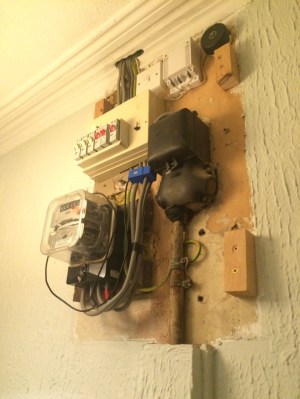When you move into a new house, there’s always something that needs fixing up. A bit of paint and some new drapes may help freshen up the place and put your mark on it, but things like exposed wiring and a very utilitarian looking electrical panel in your front hall are altogether different. Unwilling to live with the mess, [John Whittington] decided to enclose his utility panel and add a Nixie tube IoT watt meter to dress things up while monitoring energy usage.
 Looking at the “before” pictures on [John]’s blog, we can see why he’d want to invest the effort – not exactly an attractive way to greet guests at the front door. A simple wooden box to replace the previous cover would have sufficed, but why pass up the opportunity to add value? [John] opted for a Nixie tube display to complement the glass of the electric meter. The Nixie modules were a bit on the pricey side, though, so with only a pair of tubes to work with, [John] came up with a clever system to indicate the scale of the display. We doubt he’ll ever see megawatt-level instantaneous power draw, but the meter is also capable of totalling energy use, and as a bonus an ESP-8266 gives lets him stream data to the web.
Looking at the “before” pictures on [John]’s blog, we can see why he’d want to invest the effort – not exactly an attractive way to greet guests at the front door. A simple wooden box to replace the previous cover would have sufficed, but why pass up the opportunity to add value? [John] opted for a Nixie tube display to complement the glass of the electric meter. The Nixie modules were a bit on the pricey side, though, so with only a pair of tubes to work with, [John] came up with a clever system to indicate the scale of the display. We doubt he’ll ever see megawatt-level instantaneous power draw, but the meter is also capable of totalling energy use, and as a bonus an ESP-8266 gives lets him stream data to the web.
We’ve featured tons of Nixie projects before – everything from clocks to cufflinks. We have to agree that [John]’s Nixie project turned out great, and it’s sure to be a conversation starter with arriving guests.
















ironically the sign uses a lot of power :P
Hmmm, he says the tubes draw 300ma each, but I’m betting that is 300ma @ 5VDC per board and the board generates the high voltage for the tube. A Nixie this size should run about 3ma @ 200VDC.
So about 3W plus whatever the micro(s) uses, let’s say 5W total. As much as a small light bulb, couple of cents a day.
couple cents a week, a kw/hour is about 10 cents
You’re right and that irony wasn’t lost on me, which was why I opted to use the minimum of only two tubes for the display.
Equally droll worthy is the Crayon Syntax Highlighter on the web page.
I wish had.io had that – and it is a WordPress plugin!!!!
I suppose the “M” as in MW is for when the reactor goes into thermal overload and starts a melt down.
Sounds like it was mostly for when it is displaying totalized power used.
the (SI) symbol for Kilo is a LOWER CASE k !
https://en.wikipedia.org/wiki/Kilo-
it also doesn’t measure real power because he does not sample the Voltage.
Pretty disappointing coming from an Engineer tbh.
LOL, I didn’t notice that. It often catches people that the k is out of sequence – G M k – m u n p
yeah but all of the is compensated by the cool factor of using Nixi tubes.
as a physicist, this pedantry pleases me!
Both good points. The incorrect Kilo is something I shall never live down, my only excuse is made the panel quickly as I was excited to see it together!
I tried to make clear in the video and blog it only shows approximate apparent power. I was tempted to sample the transformer for the bell that happened to be in the vicinity of the meter but opted for simplicity over accuracy – especially given the inherent rounding that using only two digits provides and existing error in a system like this.
“it also doesn’t measure real power because he does not sample the Voltage.”
Uh, the voltage is pretty constant. So power is voltage times current. You can also use current squared times resistance (or impedance) if you know it. The clamp-on current sensors can be pretty accurate depending on how you handle the phase, etc.
Excellent work!
For v.2 I’d suggest putting a motion detector on it so that the filaments aren’t running all the time, but that’s a minor thing. What a great looking build!
Hi John,
Great idea, and looks the part! Thought you might like to see what a Nixie Power monitor looks like at the Power station end! http://www.bad-dog-designs.co.uk/primrose.html